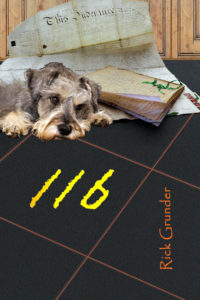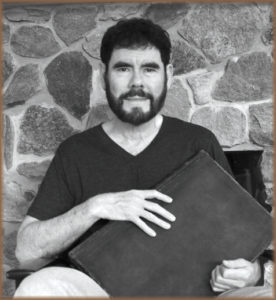 Rick Grunder introduces his Mormon murder biblio-mystery novel 116.
Rick Grunder introduces his Mormon murder biblio-mystery novel 116.
“That’s his grave, over there.”
Faithful billionaire Preston Young tries to entertain Solomon Slyde whom he has fetched from the East to find the lost 116 pages of the original Book of Mormon manuscript.
“He died in 1877.”
“Is your ancestor buried here, too?” Sol looked across the manicured oasis nestled between ordinary-looking buildings.
“No, Lorenzo Dow Young was the youngest brother. There was only room here for Brigham and a few of his wives. See, here’s Eliza R. Snow, the poetess of Mormonism. She married Joseph Smith first, of course, as part of the Principle.”
“The principal?” queried Sol. “You mean as property, like land and cattle?” Nothing about Mormonism surprised Sol by now.
Preston looked at him funny. “The Principle of Plural Marriage. What people call ‘polygamy.’”
Sol stayed silent. Joh had once quipped to him coyly that “No religion has had as much sex as Mormonism – and been so afraid of it.”
Researching Mormon bibliography provides limited opportunities to record thoughts like that, so in 1997 I decided to start a story. It wouldn’t be “the great American novel,” but it might be fun. Fiction, after all, is merely history before it happens, right? Except it wasn’t quite the vacation I’d planned.
To do a good job, I guess a novelist has to get naked in front of the readers. A full dermatological examination may not be indicated, but a few flaws should show, or people won’t believe you. You don’t have to be pretty, just not-boring. Challenge enough. But wait! There was more.
A lifetime of historiography and excruciating detail may supply fodder for a narrative, but it doesn’t do much for the distribution. Drafting the plot, for example, and establishing timeline and continuity required a few years’ spare time. And readers don’t typically open a novel to invest more than they get out of the thing. Unfortunately, I’m one of those people who talk in complete paragraphs, so that had to be fixed as well.
Then, the hardest part of all: I finally sensed that to do any good, decent fiction must give up things I’d worked hard to hold back. Clarity, confession, spirituality. It was like having to grow up all over again. My personal faith journey had been extraordinarily tough, but ultimately final. How to share the useful parts of it without imposing? That, plus getting naked at such an age, and the paragraph thing, assured that my callow literary experiment would turn into trial and an exhilaration.
There were also easy parts. The least admirable of my characters wrote themselves without much effort. Anecdotes and technicalities relating to the world of rare books and manuscripts were a piece of cake. Complaining and criticizing came quite readily. It was fun fleshing out the ancient character of Lehi –and I do mean flesh. I’m afraid he wasn’t quite so pristine initially as Joseph Smith thought, but he achieves sympathetic righteousness by the end of the book. His Elizabethan-aped manner of speech was more Smith than precise King James Bible, so the recipe wasn’t too tricky (including a dollop of chiasmus in Lehi’s prayer to the Queen of Heaven–if you’re into that sort of thing).
There had to be depth here, and tolerance, and genuine space for people I don’t agree with (“people with whom I do not agree,“ Mabel Thornduke would correct, rectifying my grammar with admirable enunciation of each consonant). We read a lot about when or whether the quintessential Mormon novel will ever be written on a par with the greatest classics of English literature. Thank goodness I wasn’t going for that. I think we take ourselves too seriously when we try to fit in by being extra-special. My object with this work was to make it as accessible to non-Mormons as to anyone else. In doing so, I wanted to be fair to both sides and provide entertainment without the usual study manual. Here’s a snippet from one of the later chapters:
So that was it. Preston needed the pages to be true. This was heavy stuff, and it wasn’t a surprise. Joh had heard the desperate thrill in collectors’ voices before. Blind enthusiasm, adequately warmed, can blast like wind off fire. Dangerous, and often unwieldy. Joh felt awkward being asked to respond to Preston so personally now because she hardly even believed in God these days, let alone the Book of Mormon.
Joh had no room for Lehi anymore, or golden plates or ancient American Christians. At least not during her sober reflections. But Joh’s real world wasn’t what Preston wanted to buy. Today she had a different job, and ironically she was the only one who could do it. Her friend Sol would never imagine how hungry Preston could be for spirit – for power to work his life. Joh’s mission, if she chose to accept it, was to revert back to little Margie from Ogden, Utah – daughter of a bishop, Daughter of Zion. She closed her eyes to take the slower breath. She would have to tread again in the place she didn’t like to go.
“Yes, Preston, I know what you’re asking. And yes, the words touched my soul, because they were filled with goodness, and generosity. I felt the potential power, no matter who penned the physical manuscript.”
Sol looked at her funny and wondered if she’d had too much coffee.
Each side looks askance at the others. It took awhile, but now these diverse characters are real, on my desk, and they sustain separate identities without crib sheets. Getting naked wasn’t so hard after all, because the writer gets to hide behind these mixed and myriad personalities. Which one is he? It doesn’t matter.
A late bookseller friend here in New York State lived long enough to read 116, and he called me from his home near Palmyra. “I recognized the culture of New York antiquarians,” he enthused, “but are people in the West really like that?” I assured him that they are, but only as a composite. Did I choose the right details for this story? Some people had to die, of course, but it was for a good cause. To reassure the timid, I don’t like lots of blood. Sweet little murders fit my preference better. If this were from a better hand, I’d aspire to a blend between The Da Vinci Code and something like Miss Marple Comes to Tea. Whatever the result, I hope that people who pick up this book will find something here to enjoy.
_____________________________________
 Rick Grunder grew up as an Idaho farm boy and sixth-generation Latter-day Saint, serving a mission to France from 1967-1970. He holds bachelor’s and master’s degrees in history from Brigham Young University where he served as the first Chairman of the BYU Library Bibliographic Department until 1981 and then an antiquarian bookseller for forty years. Set deep in the woods of Central New York, Rick Grunder – Books is located an hour’s drive from both Palmyra, New York, and Susquehanna County, Pennsylvania, places where Mormonism began. In a setting such as this, amazing things can happen.
Rick Grunder grew up as an Idaho farm boy and sixth-generation Latter-day Saint, serving a mission to France from 1967-1970. He holds bachelor’s and master’s degrees in history from Brigham Young University where he served as the first Chairman of the BYU Library Bibliographic Department until 1981 and then an antiquarian bookseller for forty years. Set deep in the woods of Central New York, Rick Grunder – Books is located an hour’s drive from both Palmyra, New York, and Susquehanna County, Pennsylvania, places where Mormonism began. In a setting such as this, amazing things can happen.
In the 1980s, Grunder knew Mark W. Hofmann, who turned out to be a forger and pipe-bomb murderer (the subject of numerous true-crime books and documentaries for which Grunder was interviewed.) During calmer times, he has issued more than a hundred detailed catalogs of rare material for sale, plus the five-volume historical reference work, Mormon Parallels: A Bibliographic Source (2008; 2014; 2018). He is co-author with Will Bagley of “‘I Could Hardly Hold the Pen’: Phebe Ann Wooley Davis’s Hard Road to Utah and Back, 1864–1865,” Overland Journal 27, no.3 (Fall 2009), and more recently with Paul E. Cohen, “The Founding Document of the Mormon West,” Utah Historical Quarterly 87, no.3 (Summer 2019).
